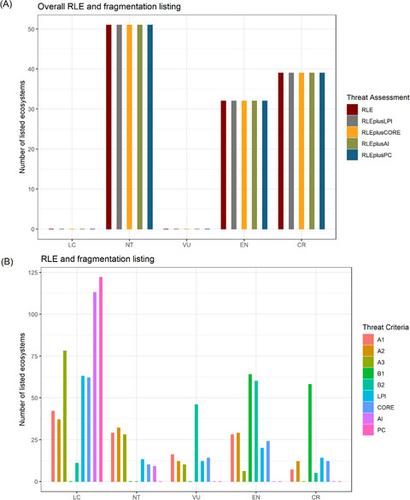当前位置:
X-MOL 学术
›
Austral Ecol.
›
论文详情
Our official English website, www.x-mol.net, welcomes your
feedback! (Note: you will need to create a separate account there.)
Assessing the threat of landscape transformation and habitat fragmentation in a global biodiversity hotspot
Austral Ecology ( IF 1.6 ) Pub Date : 2021-04-13 , DOI: 10.1111/aec.13037 Nasiphi K. Ntshanga 1, 2 , Serban Procheş 1 , Jasper A. Slingsby 2, 3
Austral Ecology ( IF 1.6 ) Pub Date : 2021-04-13 , DOI: 10.1111/aec.13037 Nasiphi K. Ntshanga 1, 2 , Serban Procheş 1 , Jasper A. Slingsby 2, 3
Affiliation

|
Habitat loss and habitat fragmentation are amongst the major drivers of biodiversity loss globally. Although habitat fragmentation poses additional threats to biodiversity beyond habitat loss alone, the IUCN’s Red List of Ecosystems (RLE) does not provide guidance on how to assess these threats. This study develops an approach for incorporating habitat fragmentation into the RLE threat assessment and investigates additional insights such an analysis could provide beyond the analysis of distribution trends. This is achieved by quantifying RLE criteria A and B (distribution reduction, restricted distribution and decline) and comparing outcomes with indices of habitat fragmentation (core area, Largest Patch Index, Patch Cohesion Index and Aggregation Index) in the Cape Floristic Region of South Africa. Results revealed that much of the Cape Floristic Region is severely threatened by both landscape transformation and habitat fragmentation, but that treating the habitat fragmentation indices as additional RLE criteria did not alter the ecosystem threat assessment outcomes. Whilst this suggests that the existing RLE criteria implicitly account for habitat fragmentation, the relationship between fragmentation indices and RLE criteria were weak and highly variable in some cases, indicating that the RLE criteria alone do not sufficiently account for the threat of habitat fragmentation. Supplementing the RLE with habitat fragmentation measures highlights additional, unique information on threats to ecosystems. This simple approach has the potential to assist in setting conservation priorities and management goals, particularly in fragmented ecosystems.
中文翻译:

评估全球生物多样性热点地区景观改造和栖息地破碎化的威胁
栖息地丧失和栖息地破碎化是全球生物多样性丧失的主要驱动因素之一。尽管栖息地破碎化除了栖息地丧失之外,还对生物多样性构成了额外威胁,但 IUCN 的生态系统红色名录 (RLE) 并未就如何评估这些威胁提供指导。本研究开发了一种将栖息地破碎化纳入 RLE 威胁评估的方法,并调查了这种分析可以提供的超出分布趋势分析的其他见解。这是通过量化 RLE 标准 A 和 B(分布减少、受限分布和下降)并将结果与南非开普省植物区系的栖息地破碎化指数(核心区、最大斑块指数、斑块凝聚指数和聚集指数)进行比较来实现的. 结果表明,开普植物区的大部分地区都受到景观转变和栖息地破碎化的严重威胁,但将栖息地破碎化指数作为额外的 RLE 标准并没有改变生态系统威胁评估结果。虽然这表明现有的 RLE 标准隐含地解释了栖息地破碎化,但破碎化指数和 RLE 标准之间的关系在某些情况下很弱且变化很大,表明单独的 RLE 标准并不能充分考虑栖息地破碎化的威胁。用栖息地破碎化措施补充 RLE 突出了有关生态系统威胁的额外、独特的信息。这种简单的方法有可能有助于设定保护优先事项和管理目标,尤其是在支离破碎的生态系统中。
更新日期:2021-04-13
中文翻译:

评估全球生物多样性热点地区景观改造和栖息地破碎化的威胁
栖息地丧失和栖息地破碎化是全球生物多样性丧失的主要驱动因素之一。尽管栖息地破碎化除了栖息地丧失之外,还对生物多样性构成了额外威胁,但 IUCN 的生态系统红色名录 (RLE) 并未就如何评估这些威胁提供指导。本研究开发了一种将栖息地破碎化纳入 RLE 威胁评估的方法,并调查了这种分析可以提供的超出分布趋势分析的其他见解。这是通过量化 RLE 标准 A 和 B(分布减少、受限分布和下降)并将结果与南非开普省植物区系的栖息地破碎化指数(核心区、最大斑块指数、斑块凝聚指数和聚集指数)进行比较来实现的. 结果表明,开普植物区的大部分地区都受到景观转变和栖息地破碎化的严重威胁,但将栖息地破碎化指数作为额外的 RLE 标准并没有改变生态系统威胁评估结果。虽然这表明现有的 RLE 标准隐含地解释了栖息地破碎化,但破碎化指数和 RLE 标准之间的关系在某些情况下很弱且变化很大,表明单独的 RLE 标准并不能充分考虑栖息地破碎化的威胁。用栖息地破碎化措施补充 RLE 突出了有关生态系统威胁的额外、独特的信息。这种简单的方法有可能有助于设定保护优先事项和管理目标,尤其是在支离破碎的生态系统中。











































 京公网安备 11010802027423号
京公网安备 11010802027423号